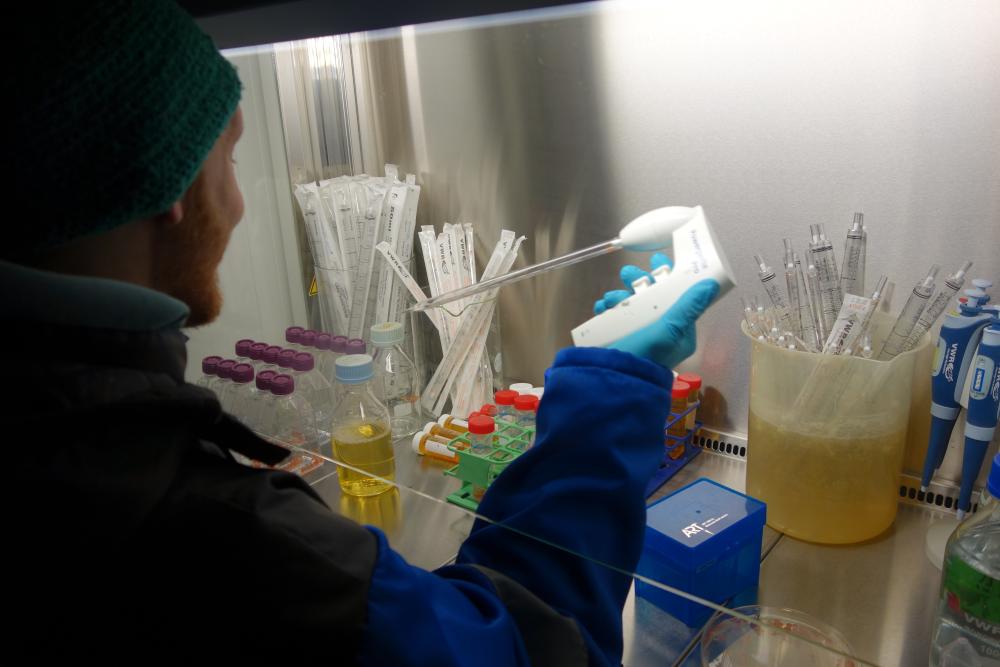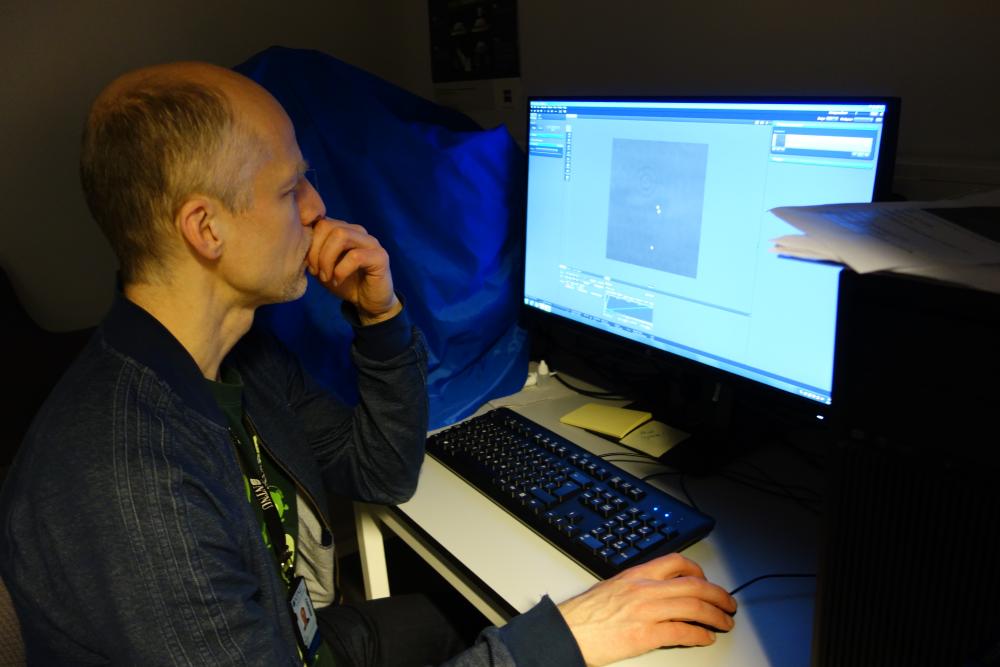Research Projects - Analysis and Control of Microbial Systems
Research Projects
Running projects
- A microbial ecological perspective on bacterial infections and treatments (2019-2023).
- Quantification of stochastic and deterministic processes during succession and invasion events in microbial communities (2019-2023)
- How to build a glass house: Revealing fundamental components of diatom cell wall biomineralization. DIASIL 2018-2022.
- Investigating the effect of bioluminescence on Vibrio campbellii’s travel time through the food chain: uptake in cod via Artemia. BIOLUMART (2018-2020).
- Strategies for functional nitrification under changing salinity regimes (2017-2020)
- Strategies for salinity increase in recirculating aquaculture systems (RAS) for Atlantic salmon post-smolts (2018-2020)

A microbial ecological perspective on bacterial infections and treatments (2019-2023).
PhD Project description – Alexander Fiedler
Traditionally, host-associated bacteria (the microbiome) were mainly studied due to their role as opportunistic pathogens or due to other negative traits. However, today we know that these microbes provide many beneficial functions to their host. One of these is the protection against harmful microorganisms like bacterial pathogens or fungal infections.
In my PhD project, these potential protective traits of the microbiome of Atlantic salmon yolk-sac fry (Salmo salar) will be investigated. Young salmon yolk-sac fry (0 – 8 weeks after hatching) will be exposed to a bacterial pathogen (Yersinia ruckeri) in the presence or absence of a healthy microbiome. The infection success of the pathogen will be examined, and the infection process will be analyzed from an ecological point of view. Further, different treatment strategies will be compared in respect to their effect on the pathogen and the fish’s microbiome: antibiotic treatment (non-specific) vs. bacteriophages against Y. ruckeri (specific). Several aspects will be considered, e.g. effects of the infection on the host and environmental microbiota, impacts and consequences of different treatment strategies and the fry’s resistance against re-infection.
Microbial communities will be characterized by deep sequencing of 16S rRNA amplicons, and the data will be analyzed by network analysis tools and multivariate statistics. Further methods involve classical microbiological techniques, raising germ-free fish (free of bacteria/archaea/fungi) and handling of bacteriophages.
This project will run for four years until autumn 2023 and is financed by the Norwegian Research Council.
Quantification of stochastic and deterministic processes during succession and invasion events in microbial communities (2019-2023)
Determining the contribution of stochastic and deterministic processes in microbial community assembly is crucial for obtaining a mechanistic understanding of the structure and function of microbial communities. Microbial invasions have during the past decade gained more attention, especially in regards to properties of the invader or resident community that facilitate invasion. However, how the assembly processes contribute to invasion success is still poorly understood. As microbial invasions can have an impact both in regard to community composition and functionality, understanding more about the invasion-process is important to be able to predict and possibly control invasion.
The overall aim of this project is to find a good framework to quantify the contributions of stochastic and deterministic process during community succession and how the processes contribute to invasion success. Main research questions are; 1) How do resource pulses and carrying capacity affect the community assembly processes during succession? 2) How do unsuccessful invasions impact community composition and functionality, and how are stochastic and deterministic processes involved in this? 3) Is the impact of invasion different when the community is cultivated continuously compared to in batch? Major activities include cultivation of natural microbial communities in bioreactors, Illumina sequencing, microscopy, flow-cytometry, niche-structure estimation (EcoPlates Biolog), plating and multivariate statistics.
One PhD candiate Madeleine Gundersen is currently supported by a scholarship from the Faculty of Natural Sciences.

How to build a glass house: Revealing fundamental components of diatom cell wall biomineralization. DIASIL 2018-2022.
See https://app.cristin.no/projects/show.jsf?id=593465
One of the most spectacular examples of biomineralization in nature is the diatom cell wall (frustule), which is a three-dimensional silica structure with intricate, species-specific patterns ranging from nano- to micrometer scale. While a number of proteins have been identified that take part in the deposition and patterning of silica within a specialized compartment (the silica deposition vesicle, SDV), the process as a whole is poorly understood. There is extensive interaction between the inside of the SDV and cytosolic factors such as the cytoskeleton, but the mechanisms of these interactions are unknown.
We have identified a gene family restricted to diatoms that encodes predicted transmembrane proteins with a yet uncharacterised domain. Several lines of evidence suggest that members of this protein family, termed Silicanins, are localized to the SDV membrane, and that they are involved in frustule biosynthesis. In this project, we aim to investigate the role of Silicanins in cell wall biomineralization, using state-of-the-art molecular, biochemical and imaging techniques.
We are generating and characterising deletion series of Silicanin family members using CRISPR/Cas9-based genome editing. Silica production and frustule patterning, structure and chemical composition will be analysed in these mutants as well as overexpression lines. The intracellular localization and dynamics of Silicanin family members and putative interaction partners will be studied. Recombinant Silicanin proteins have been produced and will be analysed for direct or indirect effect on silica formation activity.
Cooperating partners:
Assoc. Prof. Per Winge, Department of Biology, NTNU
Prof. Nils Kröger, Technische Universität Dresden
Investigating the effect of bioluminescence on Vibrio campbellii’s travel time through the food chain: uptake in cod via Artemia. BIOLUMART (2018-2020).
Our research group is involved in the study of quorum sensing (QS) and quorum quenching (QQ) related to bacterial diseases in aquaculture. QS is the regulation of gene expression in response to levels of signal molecules, often correlated to the cell-population density in bacteria. QS describes to the ability of a bacterium to sense information from other cells in the population when reaching a specific concentration. A lot of knowledge and information about the functions of quorum sensing in various bacterial species is available. To mention some, both osmotic stress, flagellar motility, bioluminescence and the regulation of virulence factors in V.campbellii (earlier V.harveyi) is regulated by quorum sensing mechanisms, and this is well documented. However, there is clearly a lack of general knowledge concerning the reasons as to why different bacteria are using so much of their energy budget on creating bioluminescence. In this project we collaborate with the research group of Peter Bossier at the Aquaculture and Artemia Reference center at Ghent University in Belgium.
The project is running for 2018-2020 financed by the AQUAEXCEL 2020 programme.
Strategies for functional nitrification under changing salinity regimes (2017-2020).
The production of Atlantic salmon (Salmo salar) in recirculating aquaculture systems (RAS) is challenged by the need for varying salinities during the different growth stages of the fish. Salinity changes can adversely impact the nitrification rate in RAS bioreactors, which are a vital part of the water treatment system for the conversion of ammonia to nitrate. As even low concentrations of ammonia and nitrite can be toxic to fish, it is necessary to find methods to change the salinity in RAS while maintaining low ammonia/nitrite concentration. The objective of the project is to develop strategies to change the salinity in nitrifying bioreactors with the least possible impact on nitrification performance.
Activities include design and construction of lab-scale moving bed biofilm reactors at Nofima, Sunndalsøra. Thereafter, we investigated different strategies to change salinity, with an aim to minimize the impact on the nitrification performance. The microbial community composition in the biofilm will be characterized by 16S rRNA gene amplicon sequencing.
The project is part of the CtrlAQUA SFI project, with several partners from industry, technology providers, and research. For this PhD project the main partners are Nofima, Krüger Kaldnes AS, and NTNU (Trondheim and Ålesund). Funding is provided by the Research Council of Norway and Krüger Kaldnes AS.
Strategies for salinity increase in recirculating aquaculture systems (RAS) for Atlantic salmon post-smolts (2018-2020)
Production of post-smolt in recirculating aquaculture systems (RAS) is becoming more common in salmon farming. Longer production time on land yield more robust fish during sea transfer and reduce exposure time with sea lice and general tough conditions off-shore. From an operational perspective, the question of whether the post-smolts should be reared in freshwater or brackish/saltwater is discussed. The latter involves that water of higher salinity is introduced into the RAS, which will change the microbiota associated with the fish. The aim of the project is to study how increased salinity in RAS affects the general microbiota, nitrification kinetics and how different operational regimes with salinity affects fish health and growth, both on land and at sea. Activities include a commercial scale experiment at the LetSea RAS facility with salinity increase rearing Atlantic salmon smolts, microbial community characterization through illumina sequencing and water quality analysis.
The project is in collaboration with LetSea in Nordland, a commercial and research fish farm. Funding is provided by LetSea AS, RFF Nord and Skattefunn.
One PhD candidate works in this project.
